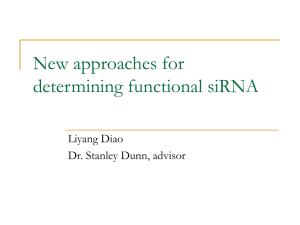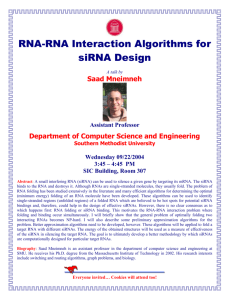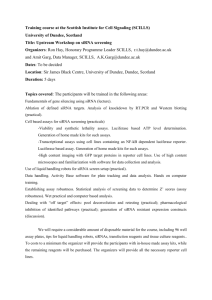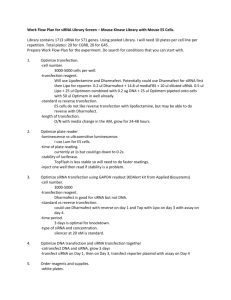MAIZE EPIGENETICS HOW ENVIRONMENT AND GENOME INTERACT
advertisement
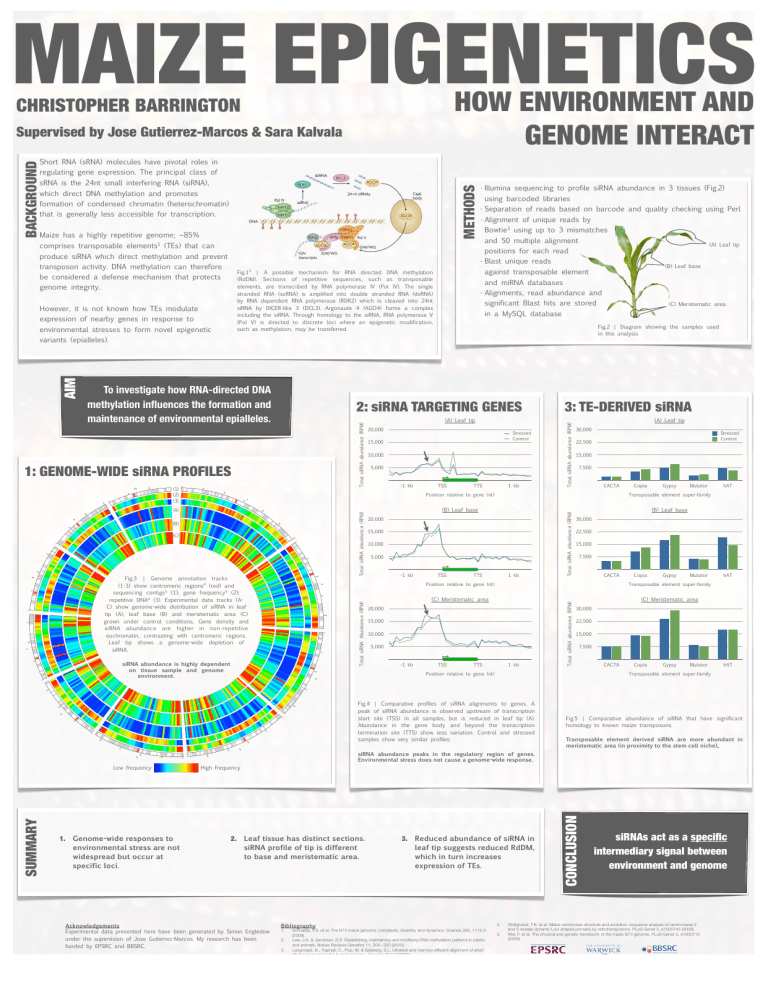
MAIZE EPIGENETICS HOW ENVIRONMENT AND GENOME INTERACT CHRISTOPHER BARRINGTON Supervised by Jose Gutierrez-Marcos & Sara Kalvala BACKGROUND Short RNA (sRNA) molecules have pivotal roles in regulating gene expression. The principal class of METHODS sRNA is the 24nt small interfering RNA (siRNA), which direct DNA methylation and promotes formation of condensed chromatin (heterochromatin) that is generally less accessible for transcription. Maize has a highly repetitive genome; ~85% • Illumina sequencing to profile siRNA abundance in 3 tissues (Fig.2) using barcoded libraries • Separation of reads based on barcode and quality checking using Perl • Alignment of unique reads by Bowtie3 using up to 3 mismatches and 50 multiple alignment comprises transposable elements1 (TEs) that can (A) Leaf tip positions for each read produce siRNA which direct methylation and prevent transposon activity. DNA methylation can therefore • Blast unique reads genome integrity. However, it is not known how TEs modulate expression of nearby genes in response to environmental stresses to form novel epigenetic and miRNA databases • Alignments, read abundance and significant Blast hits are stored in a MySQL database (1) (2) (3) (A) Leaf tip 20,000 Stressed Control 15,000 10,000 5,000 -1 kb TSS TTS 1 kb 3: TE-DERIVED siRNA Total siRNA abundance (RPM) Total siRNA abundance (RPM) (A) Leaf tip 30,000 Stressed Control 22,500 15,000 7,500 CACTA Position relative to gene (nt) (B) (C) Fig.3 | Genome annotation tracks (1-3) show centromeric regions4 (red) and sequencing contigs5 (1); gene frequency4 (2); repetitive DNA4 (3). Experimental data tracks (AC) show genome-wide distribution of siRNA in leaf tip (A), leaf base (B) and meristematic area (C) grown under control conditions. Gene density and siRNA abundance are higher in non-repetitive euchromatin, contrasting with centromeric regions. Leaf tip shows a genome-wide depletion of siRNA. (B) Leaf base 20,000 15,000 10,000 5,000 -1 kb TSS TTS 1 kb Total siRNA abundance (RPM) Total siRNA abundance (RPM) (A) Total siRNA Abundance (RPM) (C) Meristematic area 15,000 10,000 5,000 TSS Mutator hAT (B) Leaf base 22,500 15,000 7,500 CACTA Copia Gypsy Mutator hAT Transposable element super-family 20,000 -1 kb Gypsy 30,000 Position relative to gene (nt) siRNA abundance is highly dependent on tissue sample and genome environment. Copia Transposable element super-family TTS 1 kb Total siRNA abundance (RPM) AIM 2: siRNA TARGETING GENES 1: GENOME-WIDE siRNA PROFILES (C) Meristematic area Fig.2 | Diagram showing the samples used in this analysis variants (epialleles). To investigate how RNA-directed DNA methylation influences the formation and maintenance of environmental epialleles. (B) Leaf base against transposable element Fig.12 | A possible mechanism for RNA directed DNA methylation (RdDM). Sections of repetitive sequences, such as transposable elements, are transcribed by RNA polymerase IV (Pol IV). The single stranded RNA (ssRNA) is amplified into double stranded RNA (dsRNA) by RNA dependent RNA polymerase (RDR2) which is cleaved into 24nt siRNA by DICER-like 3 (DCL3). Argonaute 4 (AGO4) forms a complex including the siRNA. Through homology to the siRNA, RNA polymerase V (Pol V) is directed to discrete loci where an epigenetic modification, such as methylation, may be transferred. be considered a defense mechanism that protects (C) Meristematic area 30,000 22,500 15,000 7,500 Position relative to gene (nt) CACTA Copia Gypsy Mutator hAT Transposable element super-family Fig.4 | Comparative profiles of siRNA alignments to genes. A peak of siRNA abundance is observed upstream of transcription start site (TSS) in all samples, but is reduced in leaf tip (A). Abundance in the gene body and beyond the transcription termination site (TTS) show less variation. Control and stressed samples show very similar profiles. Fig.5 | Comparative abundance of siRNA that have significant homology to known maize transposons. Transposable element derived siRNA are more abundant in meristematic area (in proximity to the stem cell niche). siRNA abundance peaks in the regulatory region of genes. Environmental stress does not cause a genome-wide response. 1. Genome-wide responses to environmental stress are not widespread but occur at specific loci. High frequency 2. Leaf tissue has distinct sections. siRNA profile of tip is different to base and meristematic area. Acknowledgements Experimental data presented here have been generated by Simon Engledow under the supervision of Jose Gutierrez-Marcos. My research has been funded by EPSRC and BBSRC. 3. Reduced abundance of siRNA in leaf tip suggests reduced RdDM, which in turn increases expression of TEs. Bibliography 1. 2. 3. Schnable, P.S. et al. The B73 maize genome: complexity, diversity, and dynamics. Science 326, 1112-5 (2009). Law, J.A. & Jacobsen, S.E. Establishing, maintaining and modifying DNA methylation patterns in plants and animals. Nature Reviews Genetics 11, 204--220 (2010). Langmead, B., Trapnell, C., Pop, M. & Salzberg, S.L. Ultrafast and memory-efficient alignment of short DNA sequences to the human genome. Genome Biol 10(2009). 4. 5. CONCLUSION SUMMARY Low frequency siRNAs act as a specific intermediary signal between environment and genome Wolfgruber, T.K. et al. Maize centromere structure and evolution: sequence analysis of centromeres 2 and 5 reveals dynamic Loci shaped primarily by retrotransposons. PLoS Genet 5, e1000743 (2009). Wei, F. et al. The physical and genetic framework of the maize B73 genome. PLoS Genet 5, e1000715 (2009).

